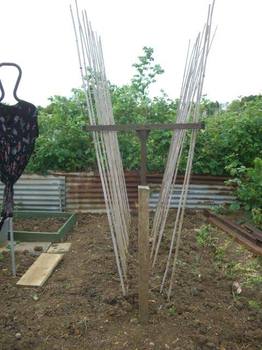Thanks to Mark Chandler for the fantastic photo!
You might find this hard to believe, but in the USA runner beans are grown as an ornamental, and are not eaten. Why, we've no idea. Here, they are one of the most popular allotment crops and one of the easiest to grow. You get a generous picking from a very small amount of ground, so they are especially valuable if you have one of the new-style mini-allotments. New plotholders will be delighted to know they will cope well with ground that hasn't been prepared to a finicky high standard, so they are an ideal first-year crop too.
Runner beans come from sub-tropical climates and are killed by frost. You can start your plants off in pots or sow direct in the open ground, but you need to time things so that the plants aren't exposed to temperatures below 5degC at night. This means sowing at the beginning of May or planting out in mid-May.
With all that top-growth to support, runner beans need plenty of water and don't like drying out in hot weather. You can help them by preparing a shallow trench under where they are going to go. Fill this in the winter with the kind of stuff you'd put in the compost heap, or prepare the ground in spring using the rough old stuff off the top of whichever compost heap you're emptying. Bury this about 4-6ins down (10-15cm) under the topsoil, and plant or sow on top. The roots will seek out the moisture in that squidgy rotting vegetable matter.
|
You will need to build a support for your beans early on. There are many ways of doing this; you can see some here. Remember, the beans, when they form, hang down and by the end of summer the plants will climb to way over your head, given the chance. The techniques shown here are designed so that the beans hang towards you, not crowded in the centre of the structure where they're easy to miss. The structure on the right is designed so the beans grow along the sloping 'roof' and hang down inside.
|
|
This variation has poles that slope outwards so the beans are easy to pick. It doesn't take up so much room and the T-frame at the ends supports the row of poles on a wire.
You can use the traditional row or wigwam, but be sure to cross the poles quite low down so the tops poke outwards and allow those dangling beans to be picked right up till September. Hazel poles are traditional but bamboo canes do just fine. 8ft bamboo canes are £2.80 for 10 at the trading store (April 2014 price) TIE YOUR CANES WITH GREEN STRING, NOT THE SOFT BEIGE STUFF. Why? Sparrows steal the beige stuff to make their nests and will undo allyour knots! |
Runner bean problems
Generally, runner beans are fairly trouble-free. The main pest they suffer from is blackfly. You will need a chemical control for this - either traditional or organic - as they can really stunt the growth and damage your crop, especially as ants will start to farm the aphids early on. Those ants (which are milking the aphids for their sugary secretions) will carefully remove all the helpful ladybird larvae, lacewing larvae and other predators who would naturally keep the aphids under control. It's Man versus Ant, and there are more of the ants!
One other problem commonly met with is - loads of flowers, but no beans. There are two main causes of this.
1. Dry weather. When the air is dry, pollen cannot start the process which leads to beans forming. In dry weather, mist or splash the bean plants with ordinary water daily.
2. Naughty bumble bees! Big fat bumble bees cannot get down the narrow flower to the nectar. So they sneak round the back and bite through the flower to reach it. In doing so, they don't actually pollinate the flowers so - no beans. The answer to this, if it becomes a problem, is to grow a white or pale pink-flowered variety.this confuses the bumble bees who have only learnt to use their trick on the bright red flowers.
One other problem commonly met with is - loads of flowers, but no beans. There are two main causes of this.
1. Dry weather. When the air is dry, pollen cannot start the process which leads to beans forming. In dry weather, mist or splash the bean plants with ordinary water daily.
2. Naughty bumble bees! Big fat bumble bees cannot get down the narrow flower to the nectar. So they sneak round the back and bite through the flower to reach it. In doing so, they don't actually pollinate the flowers so - no beans. The answer to this, if it becomes a problem, is to grow a white or pale pink-flowered variety.this confuses the bumble bees who have only learnt to use their trick on the bright red flowers.



